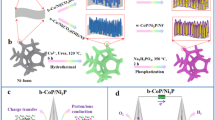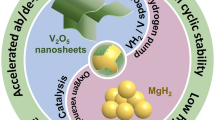Abstract
Designing highly efficient and low-cost electrocatalysts for oxygen evolution reaction is important for many renewable energy applications. In particular, strain engineering has been demonstrated as a powerful strategy to enhance the electrochemical performance of catalysts; however, the required complex catalyst preparation process restricts the implementation of strain engineering. Herein, we report a simple self-template method to prepare hierarchical porous Co3O4 nanowires (PNWs) with tunable compressive strain via thermal-oxidation-transformation of easily prepared oxalic acid-cobalt nitrate (Co(NO3)2) composite nanowires. Based on the complementary theoretical and experimental studies, the selection of proper solvents in the catalyst preparation is not only vital for the hierarchical structural evolution of Co3O4 but also for regulating their compressive surface strain. Because of the rich surface active sites and optimized electronic Co d band centers, the PNWs exhibit the excellent activity and stability for oxygen evolution reaction, delivering a low overpotential of 319 mV at 10 mA·cm−2 in 1 M KOH with a mass loading 0.553 mg·cm−2, which is even better than the noble metal catalyst of RuO2. This work provides a cost-effective example of porous Co3O4 nanowire preparation as well as a promising method for modification of surface strain for the enhanced electrochemical performance.

Similar content being viewed by others
References
Suen, N. T.; Hung, S. F.; Quan, Q.; Zhang, N.; Xu, Y. J.; Chen, H. M. Electrocatalysis for the oxygen evolution reaction: Recent development and future perspectives. Chem. Soc. Rev. 2017, 46, 337–365.
Seh, Z. W.; Kibsgaard, J.; Dickens, C. F.; Chorkendorff, I.; Nørskov, J. K.; Jaramillo, T. F. Combining theory and experiment in electrocatalysis: Insights into materials design. Science 2017, 355, eaad4998.
Zhao, Z. J.; Liu, S. H.; Zha, S. J.; Cheng, D. F.; Studt, F.; Henkelman, G.; Gong, J. L. Theory-guided design of catalytic materials using scaling relationships and reactivity descriptors. Nat. Rev. Mater. 2019, 4, 792–804.
Song, F.; Bai, L. C.; Moysiadou, A.; Lee, S.; Hu, C.; Liardet, L.; Hu, X. L. Transition metal oxides as electrocatalysts for the oxygen evolution reaction in alkaline solutions: An application-inspired renaissance. J. Am. Chem. Soc. 2018, 140, 7748–7759.
Wei, Q. L.; Xiong, F. Y.; Tan, S. H.; Huang, L.; Lan, E. H.; Dunn, B.; Mai, L. Q. Porous one-dimensional nanomaterials: Design, fabrication and applications in electrochemical energy storage. Adv. Mater. 2017, 29, 1602300–1602338.
Xu, C. L.; Zhao, Y. Q.; Yang, G. W.; Li, F. S.; Li, H. L. Mesoporous nanowire array architecture of manganese dioxide for electrochemical capacitor applications. Chem. Commun. 2009, 48, 7575–7577.
Liu, H.; Wexler, D.; Wang, G. X. One-pot facile synthesis of iron oxide nanowires as high capacity anode materials for lithium ion batteries. J. Alloys Compd. 2009, 487, 24–27.
Li, Y. G.; Tan, B.; Wu, Y. Y. Mesoporous Co3O4 nanowire arrays for lithium ion batteries with high capacity and rate capability. Nano Lett. 2008, 8, 265–270.
Lu, X. H.; Yu, M. H.; Zhai, T.; Wang, G. M.; Xie, S. L.; Liu, T. Y.; Liang, C. L.; Tong, Y. X.; Li, Y. High energy density asymmetric quasi-solid-state supercapacitor based on porous vanadium nitride nanowire anode. Nano Lett. 2013, 13, 2628–2633.
Bilousov, O. V.; Geaney, H.; Carvajal, J. J.; Zubialevich, V Z.; Parbrook, P. J.; Giguère, A.; Drouin, D.; Díaz, F.; Aguiló, M.; O’Dwyer, C. Fabrication of p-type porous GaN on silicon and epitaxial GaN. Appl. Phys. Lett. 2013, 103, 112103–112108.
Liu, H. J.; Jin, L. H.; He, P.; Wang, C. X.; Xia, Y. Y. Direct synthesis of mesoporous carbon nanowires in nanotubes using MnO2 nanotubes as a template and their application in supercapacitors. Chem. Commun. 2009, 6813–6815.
Li, W.; Zhang, F.; Dou, Y. Q.; Wu, Z. X.; Liu, H. J.; Qian, X. F.; Gu, D.; Xia, Y. Y.; Tu, B.; Zhao, D. Y. A self-template strategy for the synthesis of mesoporous carbon nanofibers as advanced supercapacitor electrodes. Adv. Energy Mater. 2011, 1, 382–386.
Ling, T.; Zhang, T.; Ge, B. H.; Han, L. L.; Zheng, L. R.; Lin, F.; Xu, Z. R.; Hu, W. B.; Du, X. W.; Davey, K. et al. Well-dispersed nickel-and zinc-tailored electronic structure of a transition metal oxide for highly active alkaline hydrogen evolution reaction. Adv. Mater. 2019, 31, 1807771–1807778.
Ling, T.; Da, P. F.; Zheng, X. L.; Ge, B. H.; Hu, Z. P.; Wu, M. Y.; Du, X. W.; Hu, W. B.; Jaroniec, M.; Qiao, S. Z. Atomic-level structure engineering of metal oxides for high-rate oxygen intercalation pseudocapacitance. Sci. Adv. 2018, 4, eaau6261.
Voiry, D.; Yamaguchi, H.; Li, J. W.; Silva, R.; Alves, D. C. B.; Fujita, T.; Chen, M. W.; Asefa, T.; Shenoy, V. B.; Eda, G. et al. Enhanced catalytic activity in strained chemically exfoliated WS2 nanosheets for hydrogen evolution. Nat. Mater. 2013, 12, 850–855.
Guan, B. Y.; Yu, X. Y.; Wu, H. B.; Lou, X. W. Complex nanostructures from materials based on metal-organic frameworks for electrochemical energy storage and conversion. Adv. Mater. 2017, 29, 1703614–1703634.
Tackett, B. M.; Sheng, W. C.; Chen, J. G Opportunities and challenges in utilizing metal-modified transition metal carbides as low-cost electrocatalysts. Joule 2017, 1, 253–263.
Yu, L.; Yu, X. Y.; Lou, X. W. The design and synthesis of hollow micro-/nanostructures: Present and future trends. Adv. Mater. 2018, 30, 1800939–1800966.
Luo, M. C.; Guo, S. J. Strain-controlled electrocatalysis on multimetallic nanomaterials. Nat. Rev. Mater. 2017, 2, 17059–17073.
Strasser, P.; Koh, S.; Anniyev, T.; Greeley, J.; More, K.; Yu, C. F.; Liu, Z. C.; Kaya, S.; Nordlund, D.; Ogasawara, H. et al. Lattice-strain control of the activity in dealloyed core-shell fuel cell catalysts. Nat. Chem. 2010, 2, 454–460.
Hammer, B.; Nerskov, J. K. Theoretical surface science and catalysis—calculations and concepts. Adv. Catal. 2000, 45, 71–129.
Li, H.; Tsai, C.; Koh, A. L.; Cai, L. L.; Contryman, A. W.; Fragapane, A. H.; Zhao, J. H.; Han, H. S.; Manoharan, H. C.; Abild-Pedersen, F. et al. Activating and optimizing MoS2 basal planes for hydrogen evolution through the formation of strained sulphur vacancies. Nat. Mater. 2016, 15, 48–53.
Ling, T.; Yan, D. Y.; Wang, H.; Jiao, Y.; Hu, Z. P.; Zheng, Y.; Zheng, L. R.; Mao, J.; Liu, H.; Du, X. W. et al. Activating cobalt(II) oxide nanorods for efficient electrocatalysis by strain engineering. Nat. Commun. 2017, 8, 1509–1516.
Chen, Y. B.; Li, H. Y.; Wang, J. X.; Du, Y. H.; Xi, S. B.; Sun, Y. M.; Sherburne, M.; Ager III, J. W.; Fisher, A. C.; Xu, Z. J. Exceptionally active iridium evolved from a pseudo-cubic perovskite for oxygen evolution in acid. Nat. Commun. 2019, 10, 572–582.
Giannozzi, P.; Andreussi, O.; Brumme, T.; Bunau, O.; Nardelli, M. B.; Calandra, M.; Car, R.; Cavazzoni, C.; Ceresoli, D.; Cococcioni, M. et al. Advanced capabilities for materials modelling with quantum ESPRESSO. J. Phys. Condens. Matter 2017, 29, 465901–465931.
Giannozzi, P.; Baroni, S.; Bonini, N.; Calandra, M.; Car, R.; Cavazzoni, C.; Ceresoli, D.; Chiarotti, G L.; Cococcioni, M.; Dabo, I. QUANTUM ESPRESSO: A modular and open-source software project for quantum simulations of materials. J. Phys. Condens. Matter 2009, 21, 395502–395521.
Perdew, J. P.; Burke, K.; Ernzerhof, M. Generalized gradient approximation made simple. Phys. Rev. Lett. 1996, 77, 3865–3868.
Grimme, S.; Antony, J.; Ehrlich, S.; Krieg, H. A consistent and accurate ab initio parametrization of density functional dispersion correction (DFT-D) for the 94 elements H-Pu. J. Chem. Phys. 2010, 132, 154104–154119.
Vanderbilt, D. Soft self-consistent pseudopotentials in a generalized eigenvalue formalism. Phys. Rev. B 1990, 41, 7892–7895.
Lejaeghere, K.; Bihlmayer, G.; Björkman, T.; Blaha, P.; Blügel, S.; Blum, V.; Caliste, D.; Castelli, I. E.; Clark, S. J.; Dal Corso, A. et al. Reproducibility in density functional theory calculations of solids. Science 2016, 351, aad3000.
Kaneti, Y. V.; Tang, J.; Salunkhe, R. R.; Jiang, X. C.; Yu, A. B.; Wu, K. C. W.; Yamauchi, Y. Nanoarchitectured design of porous materials and nanocomposites from metal-organic frameworks. Adv. Mater. 2017, 29, 1604898–1604938.
Wei, R. J.; Fang, M.; Dong, G. F.; Lan, C. Y.; Shu, L.; Zhang, H.; Bu, X. M.; Ho, J. C. High-index faceted porous Co3O4 nanosheets with oxygen vacancies for highly efficient water oxidation. ACS Appl. Mater. Interfaces 2018, 10, 7079–7086.
Lai, J. P.; Niu, W. X.; Luque, R.; Xu, G. B. Solvothermal synthesis of metal nanocrystals and their applications. Nano Today 2015, 10, 240–267.
Wei, Q. L.; Xiong, F. Y.; Tan, S. S.; Huang, L.; Lan, E. H.; Dunn, B.; Mai, L. Q. Porous one-dimensional nanomaterials: Design, fabrication and applications in electrochemical energy storage. Adv. Mater. 2017, 29, 1602300–1602339.
Ren, L.; Wang, P. P.; Han, Y. S.; Hu, C. W.; Wei, B. Q. Synthesis of CoC2O4·2H2O nanorods and their thermal decomposition to Co3O4 nanoparticles. Chem. Phys. Lett. 2009, 476, 78–83.
Hunter, B. M.; Hieringer, W.; Winkler, J. R.; Gray, H. B.; Müller, A. M. Effect of interlayer anions on [NiFe]-LDH nanosheet water oxidation activity. Energy Environ. Sci. 2016, 9, 1734–1743.
Cai, Z. Y.; Bu, X. M.; Wang, P.; Ho, J. C.; Yang, J. H.; Wang, X. Y. Recent advances in layered double hydroxide electrocatalysts for the oxygen evolution reaction. J. Mater. Chem. A 2019, 7, 5069–5089.
Tang, T.; Jiang, W. J.; Niu, S.; Liu, N.; Luo, H.; Chen, Y. Y.; Jin, S. F.; Gao, F.; Wan, L. J.; Hu, J. S. Electronic and morphological dual modulation of cobalt carbonate hydroxides by Mn doping toward highly efficient and stable bifunctional electrocatalysts for overall water splitting. J. Am. Chem. Soc. 2017, 139, 8320–8328.
Bu, X. M.; Wei, R. J.; Gao, W.; Lan, C. Y.; Ho, J. C. A unique sandwich structure of a CoMnP/Ni2P/NiFe electrocatalyst for highly efficient overall water splitting. J. Mater. Chem. A 2019, 7, 12325–12332.
Liang, X. G.; Dong, R. T.; Li, D. P.; Bu, X. M.; Li, F. Z.; Shu, L.; Wei, R. J.; Ho, J. C. Coupling of nickel boride and Ni(OH)2 nanosheets with hierarchical interconnected conductive porous structure synergizes the oxygen evolution reaction. ChemCatChem 2018, 10, 4555–4561.
Anantharaj, S.; Kundu, S. Do the evaluation parameters reflect intrinsic activity of electrocatalysts in electrochemical water splitting? ACS Energy Lett. 2019, 4, 1260–1264.
Lu, X. Y.; Zhao, C. Electrodeposition of hierarchically structured three-dimensional nickel-iron electrodes for efficient oxygen evolution at high current densities. Nat. Commun. 2015, 6, 6616–6623.
Acknowledgements
This work is financially supported by the General Research Fund (CityU 11211317) and the Theme-Based Research Scheme (T42-103/16-N) of the Research Grants Council of Hong Kong SAR, China, the National Natural Science Foundation of China (No. 51672229), and the Science Technology and Innovation Committee of Shenzhen Municipality (No. JCYJ20170818095520778).
Author information
Authors and Affiliations
Corresponding authors
Electronic Supplementary Material
Rights and permissions
About this article
Cite this article
Bu, X., Liang, X., Egbo, K.O. et al. Morphology and strain control of hierarchical cobalt oxide nanowire electrocatalysts via solvent effect. Nano Res. 13, 3130–3136 (2020). https://doi.org/10.1007/s12274-020-2983-6
Received:
Revised:
Accepted:
Published:
Issue Date:
DOI: https://doi.org/10.1007/s12274-020-2983-6




